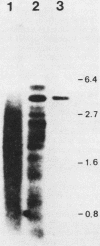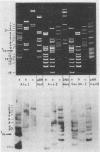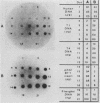Abstract
The isolation and some characteristics of a very sensitive DNA probe for the detection of Plasmodium falciparum are described. The probe is species specific and represents a large, albeit variable, fraction of the genome in all the strains tested. In addition to its immediate practical uses for the detection and quantitation of parasites, the probe defines an interesting family of repeated sequences.
Full text
PDF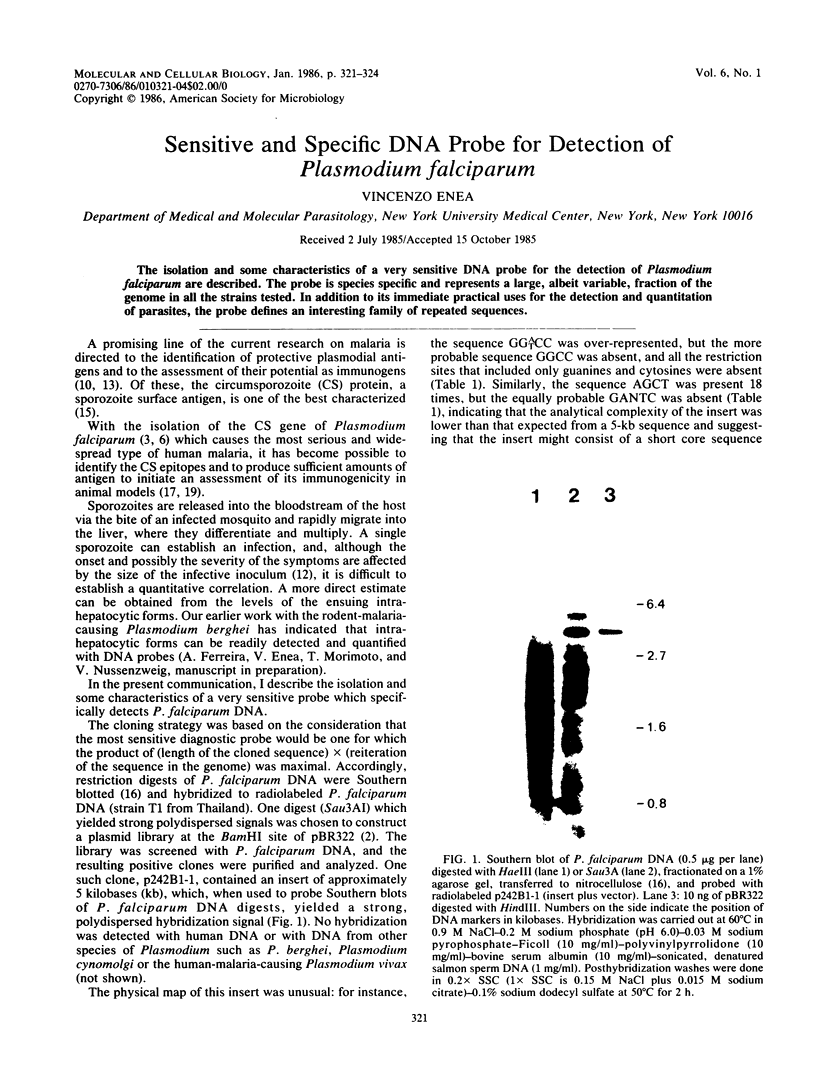

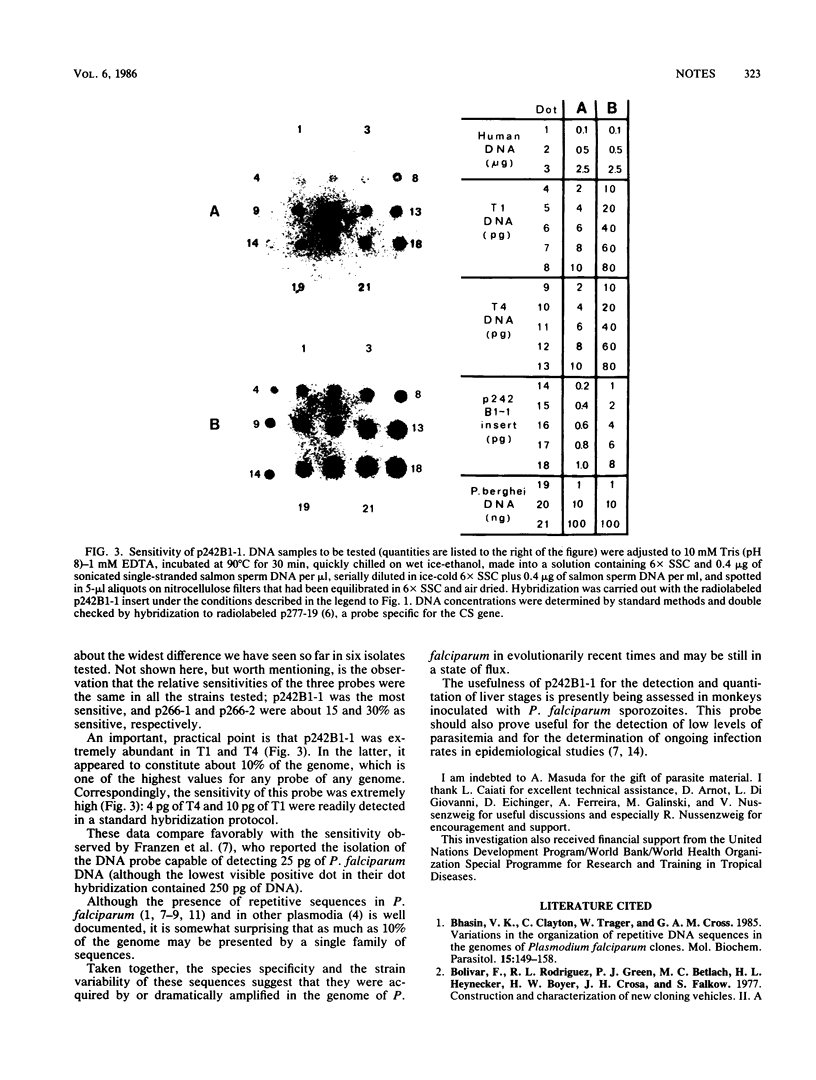
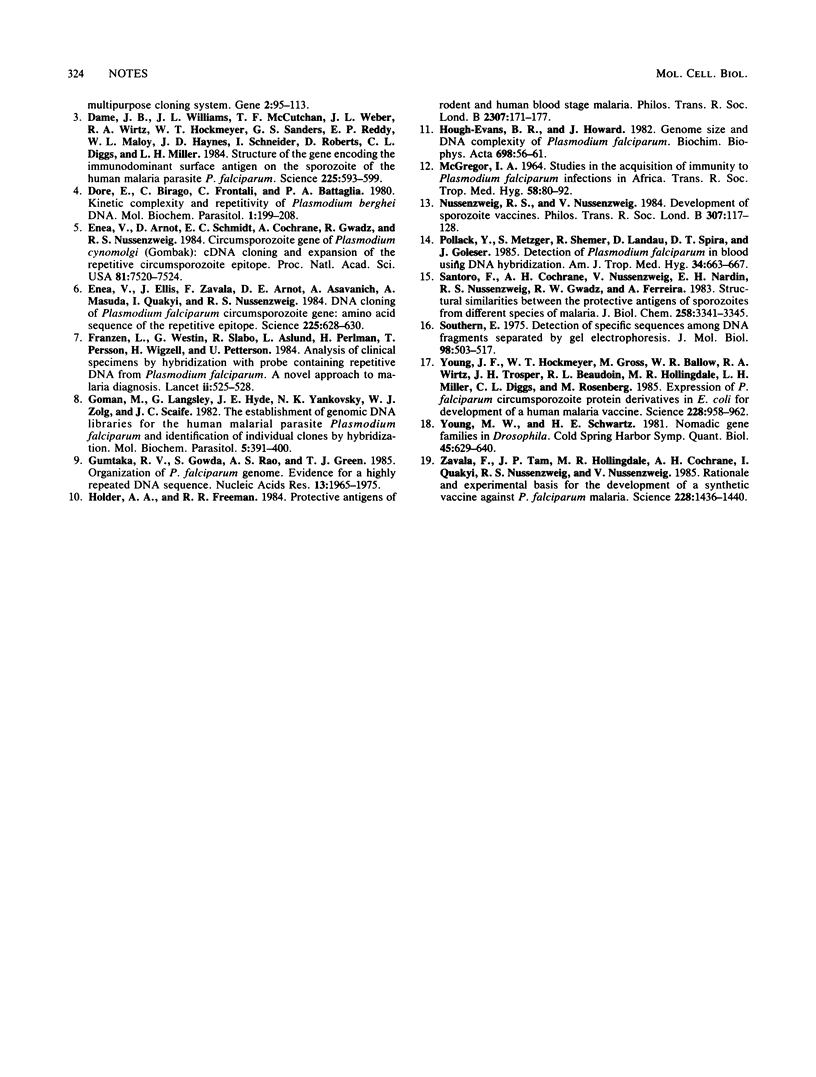
Images in this article
Selected References
These references are in PubMed. This may not be the complete list of references from this article.
- Bhasin V. K., Clayton C., Trager W., Cross G. A. Variations in the organization of repetitive DNA sequences in the genomes of Plasmodium falciparum clones. Mol Biochem Parasitol. 1985 May;15(2):149–158. doi: 10.1016/0166-6851(85)90116-1. [DOI] [PubMed] [Google Scholar]
- Dame J. B., Williams J. L., McCutchan T. F., Weber J. L., Wirtz R. A., Hockmeyer W. T., Maloy W. L., Haynes J. D., Schneider I., Roberts D. Structure of the gene encoding the immunodominant surface antigen on the sporozoite of the human malaria parasite Plasmodium falciparum. Science. 1984 Aug 10;225(4662):593–599. doi: 10.1126/science.6204383. [DOI] [PubMed] [Google Scholar]
- Enea V., Arnot D., Schmidt E. C., Cochrane A., Gwadz R., Nussenzweig R. S. Circumsporozoite gene of plasmodium cynomolgi (Gombak):cDNA cloning and expression of the repetitive circumsporozoite epitope. Proc Natl Acad Sci U S A. 1984 Dec;81(23):7520–7524. doi: 10.1073/pnas.81.23.7520. [DOI] [PMC free article] [PubMed] [Google Scholar]
- Enea V., Ellis J., Zavala F., Arnot D. E., Asavanich A., Masuda A., Quakyi I., Nussenzweig R. S. DNA cloning of Plasmodium falciparum circumsporozoite gene: amino acid sequence of repetitive epitope. Science. 1984 Aug 10;225(4662):628–630. doi: 10.1126/science.6204384. [DOI] [PubMed] [Google Scholar]
- Franzén L., Westin G., Shabo R., Aslund L., Perlmann H., Persson T., Wigzell H., Pettersson U. Analysis of clinical specimens by hybridisation with probe containing repetitive DNA from Plasmodium falciparum. A novel approach to malaria diagnosis. Lancet. 1984 Mar 10;1(8376):525–528. doi: 10.1016/s0140-6736(84)90929-2. [DOI] [PubMed] [Google Scholar]
- Goman M., Langsley G., Hyde J. E., Yankovsky N. K., Zolg J. W., Scaife J. G. The establishment of genomic DNA libraries for the human malaria parasite Plasmodium falciparum and identification of individual clones by hybridisation. Mol Biochem Parasitol. 1982 Jun;5(6):391–400. doi: 10.1016/0166-6851(82)90012-3. [DOI] [PubMed] [Google Scholar]
- Guntaka R. V., Gowda S., Rao A. S., Green T. J. Organization of Plasmodium falciparum genome: 1. Evidence for a highly repeated DNA sequence. Nucleic Acids Res. 1985 Mar 25;13(6):1965–1975. doi: 10.1093/nar/13.6.1965. [DOI] [PMC free article] [PubMed] [Google Scholar]
- Holder A. A., Freeman R. R. Protective antigens of rodent and human bloodstage malaria. Philos Trans R Soc Lond B Biol Sci. 1984 Nov 13;307(1131):171–177. doi: 10.1098/rstb.1984.0117. [DOI] [PubMed] [Google Scholar]
- Hough-Evans B. R., Howard J. Genome size and DNA complexity of Plasmodium falciparum. Biochim Biophys Acta. 1982 Jul 30;698(1):56–61. doi: 10.1016/0167-4781(82)90184-1. [DOI] [PubMed] [Google Scholar]
- MCGREGOR I. A. STUDIES IN THE ACQUISITION OF IMMUNITY OF PLASMODIUM FALCIPARUM INFECTIONS IN AFRICA. Trans R Soc Trop Med Hyg. 1964 Jan;58:80–92. doi: 10.1016/0035-9203(64)90073-2. [DOI] [PubMed] [Google Scholar]
- Nussenzweig R. S., Nussenzweig V. Development of sporozoite vaccines. Philos Trans R Soc Lond B Biol Sci. 1984 Nov 13;307(1131):117–128. doi: 10.1098/rstb.1984.0113. [DOI] [PubMed] [Google Scholar]
- Pollack Y., Metzger S., Shemer R., Landau D., Spira D. T., Golenser J. Detection of Plasmodium falciparum in blood using DNA hybridization. Am J Trop Med Hyg. 1985 Jul;34(4):663–667. doi: 10.4269/ajtmh.1985.34.663. [DOI] [PubMed] [Google Scholar]
- Santoro F., Cochrane A. H., Nussenzweig V., Nardin E. H., Nussenzweig R. S., Gwadz R. W., Ferreira A. Structural similarities among the protective antigens of sporozoites from different species of malaria parasites. J Biol Chem. 1983 Mar 10;258(5):3341–3345. [PubMed] [Google Scholar]
- Southern E. M. Detection of specific sequences among DNA fragments separated by gel electrophoresis. J Mol Biol. 1975 Nov 5;98(3):503–517. doi: 10.1016/s0022-2836(75)80083-0. [DOI] [PubMed] [Google Scholar]
- Young J. F., Hockmeyer W. T., Gross M., Ballou W. R., Wirtz R. A., Trosper J. H., Beaudoin R. L., Hollingdale M. R., Miller L. H., Diggs C. L. Expression of Plasmodium falciparum circumsporozoite proteins in Escherichia coli for potential use in a human malaria vaccine. Science. 1985 May 24;228(4702):958–962. doi: 10.1126/science.2988125. [DOI] [PubMed] [Google Scholar]
- Young M. W., Schwartz H. E. Nomadic gene families in Drosophila. Cold Spring Harb Symp Quant Biol. 1981;45(Pt 2):629–640. doi: 10.1101/sqb.1981.045.01.081. [DOI] [PubMed] [Google Scholar]
- Zavala F., Tam J. P., Hollingdale M. R., Cochrane A. H., Quakyi I., Nussenzweig R. S., Nussenzweig V. Rationale for development of a synthetic vaccine against Plasmodium falciparum malaria. Science. 1985 Jun 21;228(4706):1436–1440. doi: 10.1126/science.2409595. [DOI] [PubMed] [Google Scholar]



